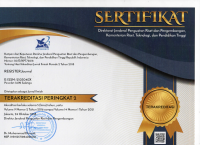The analysis of language attitude of gen-Z students towards EFL in urban and suburban areas
Abstract
Analyzing EFL students’ language attitudes is essential, given the uniform national curriculum across Indonesia. The urban-suburban EFL proficiency gap shows greater challenges for suburban teachers. This study explores Gen-Z students' attitudes toward EFL in South and West Sulawesi. A mixed-method (Qual-Quan) design was used, combining classroom observations and interviews to gather concrete data on students’ reactions to English use in the teaching-learning process, conducted over three separate days. The researchers distributed a 14-item language attitude questionnaire covering beliefs, feelings, and tendencies. The research finds that urban Gen-Z students showed generally positive attitudes—enthusiastic, adaptable, and willing to use English even when optional, while still retaining regional accents with pride. In short, They were found to adapt linguistically to their interlocutors, indicating openness and pride in using English despite retaining traces of their regional accent. In contrast, suburban students showed mostly negative attitudes toward English, often mocking peers’ mistakes and feeling shy to speak. Yet, in individual tasks, they were more serious, revealing resistance shaped by peer pressure and strong local language loyalty. The findings underscore the significant role of social context, peer influence, and ethnolinguistic identity in shaping language attitudes among Generation Z in multilingual regions. Nonetheless, the researchers would highly recommend for future scholars to develop specific EFL curriculum for suburban students for better outcomes on English mastery.
Keywords
Full Text:
PDFReferences
Albury, N. (2020). 18 Language attitudes and ideologies on linguistic diversity. Handbook of Home Language Maintenance and Development: Social and Affective Factors, 18, 357. https://doi.org/10.1515/9781501510175-018
Alhazmi, L. M. (2023). Language attitudes in fast-growing societies: new insights in the dynamism dimension. Humanities and Social Sciences Communications, 10(1), 1–14. https://doi.org/10.1057/s41599-023-01988-1
Bronfenbrenner, U. (2019). The context of development and the development of context. In Developmental psychology (pp. 147–184). Routledge. https://dx.doi.org/10.4324/9780367816247-6
Curtis, R., Robertson, A., & Mahony, I. (2019). Intercultural language learning: the Indonesian for Teachers Initiative (InTI) experience. Language and Intercultural Communication, 19(4), 357–370. https://doi.org/10.1080/14708477.2018.1545778
Dragojevic, M. (2017). Language attitudes. In Oxford research encyclopedia of communication. https://doi.org/10.1093/acrefore/9780190228613.013.437
Gardner, R. C. (2001). Language learning motivation: The student, the teacher, and the researcher. Texas Papers in Foreign Language Education, 6(1), 1–18. https://eric.ed.gov/?id=ED464495
Giles, H. (2016). Communication accommodation theory: Negotiating personal relationships and social identities across contexts. Cambridge University Press. https://dx.doi.org/10.1017/CBO9781316226537
Giles, H., Coupland, J., & Coupland, N. (1991). Contexts of accommodation: Developments in applied sociolinguistics. Cambridge University Press. https://psycnet.apa.org/doi/10.1017/CBO9780511663673
Honer, A., & Hitzler, R. (2015). Life-world-analytical ethnography: A phenomenology-based research approach. Journal of Contemporary Ethnography, 44(5), 544–562. https://doi.org/10.1177/0891241615588589
Intiana, S. R. H., Prihartini, A. A., Handayani, F., Mar’i, M., & Faridi, K. (2023). Independent curriculum and the Indonesian language education throughout the era of society 5.0: A literature review. Al-Ishlah: Jurnal Pendidikan, 15(1), 911–921. https://doi.org/10.35445/alishlah.v15i1.3140
Ivankova, N. V, & Creswell, J. W. (2009). Mixed methods. Qualitative Research in Applied Linguistics: A Practical Introduction, 23, 135–161. https://doi.org/10.1057/9780230239517
Kayaalp, D. (2016). Living with an accent: A sociological analysis of linguistic strategies of immigrant youth in Canada. Journal of Youth Studies, 19(2), 133–148. https://doi.org/10.1080/13676261.2015.1052050
Kirilenko, S. V. (2024). Language attitudes: sociolinguistic aspect. Научный Результат. Вопросы Теоретической и Прикладной Лингвистики, 10(1), 17–30. https://doi.org/10.18413/2313-8912-2024-10-1-0-2
Kirkpatrick, A., & Liddicoat, A. J. (2017). Language education policy and practice in East and Southeast Asia. Language Teaching, 50(2), 155–188. https://doi.org/10.1017/S0261444817000027
Kozulin, A. (1998). Psychological tools: A sociocultural approach to education. Harvard University Press. https://dx.doi.org/10.14712/12128112.4411
Labov, W. (1972). The social setting of linguistic change. Sociolinguistic Patterns, 260–325. https://doi.org/10.1017/S0047404500004528
Lambert, D., Solem, M., & Tani, S. (2015). Achieving human potential through geography education: A capabilities approach to curriculum making in schools. Annals of the Association of American Geographers, 105(4), 723–735. https://doi.org/10.1080/00045608.2015.1022128
Macaro, E., Curle, S., Pun, J., An, J., & Dearden, J. (2018). A systematic review of English medium instruction in higher education. Language Teaching, 51(1), 36–76. https://doi.org/10.1017/S0261444817000350
Milroy, L. (2005). Social network and language maintenance. In Language, communication and education (pp. 70–81). Routledge.
Palinkas, L. A. (2022). Mixed method designs. In Implementation Science (pp. 118–122). Routledge.
Paradewari, D. S., & Mbato, C. L. (2018). Language attitudes of Indonesians as EFL learners, gender, and socio-economic status. LLT Journal: A Journal on Language and Language Teaching, 21(1), 114–123. https://dx.doi.org/10.24071/llt.v21i1.1051
Sabiq, A. H. A. (2023). Investigating Individual Differences, School Locality, and Management on Indonesian Students’ Attitudes and Motivation in EFL Learning. LEARN Journal: Language Education and Acquisition Research Network, 16(1), 726–752.
Shin, S. J. (2017). Bilingualism in schools and society: Language, identity, and policy. Routledge. https://doi.org/10.4324/9781315535579
Sidauruk, J. M., Susilowati, M., & Akbar, K. K. (2025). Indonesia’s Struggle with Education Inequality: Is Reform the Answer? Indonesia Discourse, 2(1). https://doi.org/10.15294/indi.v2i1.23035
Sohid, A. N., & Rifai, I. (2022). Language attitude of generation z: gender and socioeconomic status analysis. Journal of Creative Practices in Language Learning and Teaching (CPLT), 10(1). https://doi.org/10.24191/cplt.v10i1.3257
Tódor, E.-M., & Dégi, Z. (2016). Language attitudes, language learning experiences and individual strategies what does school offer and what does it lack? Acta Universitatis Sapientiae, Philologica, 8(2), 123–137. https://doi.org/10.1515/ausp-2016-0022
Tranow, U. (2019). Solidarity as a System of Norms. Solidarity in Open Societies, 25–55. https://doi.org/10.1007/978-3-658-23641-0_3
Trudgill, P. (1999). Dialect Contact, Dialectology and Socionlinguistics. Cuadernos de Filología Inglesa, 8. https://dx.doi.org/10.4324/9781315856933
Widodo, H. P. (2016). Language policy in practice: Reframing the English language curriculum in the Indonesian secondary education sector. English Language Education Policy in Asia, 127–151. https://doi.org/10.1007/978-3-319-22464-0_6
Winaldo, M. D., & Oktaviani, L. (2022). Influence of video games on the acquisition of the English language. J. English Lang. Teach. Learn, 3(2), 21–26. https://doi.org/10.33365/jeltl.v3i2.1953
Zein, M. S. (2017). Elementary English education in Indonesia: Policy developments, current practices, and future prospects: How has Indonesia coped with the demand for teaching English in schools? English Today, 33(1), 53–59. https://doi.org/10.1017/S0266078416000407
DOI: https://dx.doi.org/10.30659/e.10.2.271-286
Refbacks
- There are currently no refbacks.
Copyright (c) 2025 Uswatunnisa Uswatunnisa, Andi Miftahul Maulidil Mursyid, Rahmat Rahmat
License URL: https://creativecommons.org/licenses/by/4.0/










